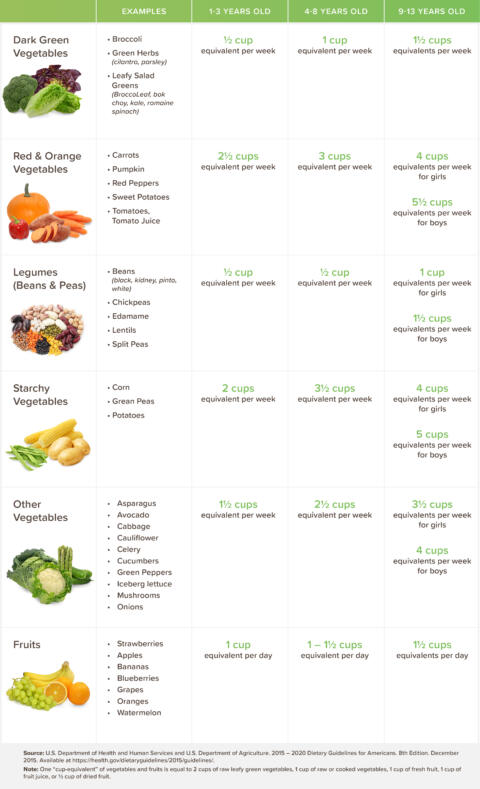Foxy Blog
Hellohealthy

How Many Vegetables and Fruits Should Your Children Really Eat?
by Tori Schmitt, MS, RDN, LD
Most children know that it’s a smart choice to choose vegetables and fruits daily. But most times, they – like adults – simply don't eat enough. Whether it’s because of the lack of availability in the home, fear of trialing new foods, or simply choosing other foods instead, most children fall short eating enough vegetables and fruit. So as children head back to school this August, let’s give them something they can really say “YES!” to: colorful, delicious nutrition!
You might be thinking: how can we help young ones get more produce each day? And, how many vegetables and fruits do children need daily anyway? In today’s blog, I’m answering some of your top questions related to produce for your tots, your teens, and all the children in between!
How many vegetables and fruits should my child eat?
As a Registered Dietitian, I’d prefer they eat as many as they can get! While that might be a lofty goal, starting with just a little bit more each day is better.
Turns out, not only do children need many vegetables and fruits, but they should get vegetables and fruits in a variety of colors. From dark green vegetables to red and orange vegetables, and even to starchy white vegetables, all bodies benefit from the unique vitamins, minerals, and phytonutrients that each color group offers.
The 2015-2020 Dietary Guidelines for Americans describe the amount of vegetables and fruits children should consume as follows:

How can I help my children eat more vegetables and fruits?
There are a variety of ways you can help your children enjoy more vegetables and fruits! I suggest incorporating vegetables and fruits at each and every meal in unique ways, like:
- Add vegetables and fruits directly into your mealtime dish,
- Add vegetables and fruits to your meal as a side dish, and
- Serve produce as a snack outside of meal time
For example, you might add a handful of spinach and steamed broccoli directly inside your child’s egg omelet at breakfast, complement your student’s lunchtime almond butter sandwich with strawberries on the side, and serve celery sticks and cauliflower florets with hummus for an afterschool snack. Then, for dinner, simply serve lettuce and tomato on your burgers (or wrap your burger in a collard green or BroccoLeaf!), add peppers and onions to your pizza, include steamed leafy greens and green herbs like parsley in your pasta dishes, or double the vegetables in your favorite casseroles and soups.
Here are some other really simple suggestions to help your child choose more vegetables and fruits:
- Add berries to breakfast. Strawberries add vitamin C, potassium, fiber and a lot of flavor when added on Greek yogurt, inside smoothies, on top of oatmeal, or simply dipped into peanut butter.
- In your student’s lunchbox, pack dippable vegetables and fruits – like chopped broccoli, cauliflower or celery – alongside single-serve packs of hummus or guacamole.
- Add an extra piece of whole fruit, like an apple, banana or orange, to the child’s lunch bag if they plan to stay afterschool for an activity, meeting, or practice.
- Add a side salad to dinner three nights of the week. Children aged 9-13 should get at least 1½ cup-equivalents of dark green vegetables each week, which actually amounts to 3 cups of leafy salad greens! To meet this goal, add one cup of BroccoLeaf, lettuce, kale, chard, spinach, or bok choy as the base of a side salad to your child’s plate three nights a week.
- Build your family’s burritos by making a “wrap” from a large BroccoLeaf, collard green, or cabbage leaf.
- Let your child choose the vegetable. Try the “this or that” technique by asking him, “would you like to have cauliflower or broccoli tonight?” This makes him the decision maker, empowering him to eat his selection once it is prepared.
- Add a side of vegetables or fruits when eating out at restaurants or fast-food locations.
- To inspire more gold medal wins, when you’re in charge of bringing a dish to the team’s post-soccer game party, bring along a vegetable tray with this Golden Cauliflower Hummus.
- Allow your child to pick out (at least!) one item from the produce section of your grocery store each time you visit together.
- Store chopped vegetables in reusable silicone storage bags so they’re ready to grab and go!
And remember, by simply having vegetables and fruits stocked in your home kitchen, you can help encourage your children to choose more. For little hands, that means having vegetables and fruits already washed, cut, and at a reachable level within the refrigerator!
For more ideas on how to help your child choose more vegetables and fruits, read the blog here.
Then, check out these back to school recipes featuring fresh Foxy vegetables and fruits, including:
How will you help your children enjoy more vegetables and fruits? Let us know your fun, healthy solutions by sharing your fruit and vegetable photos with us on Instagram and tagging us @ToriSchmittRDN and @FoxyProduce!


